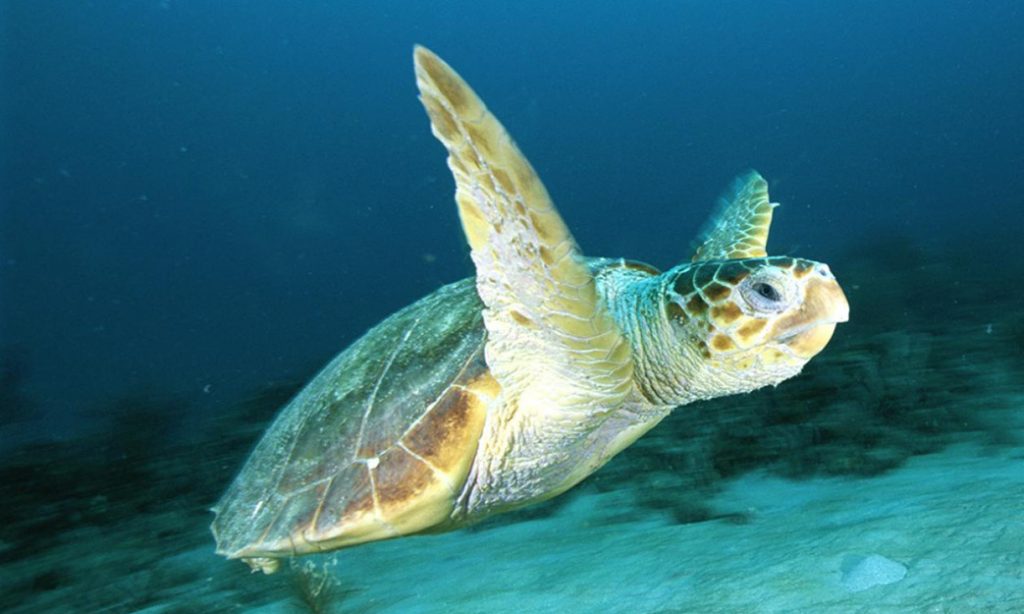By Bryan Vorbach, Associate Veterinarian, South Carolina Aquarium

Nearly all of the threats facing sea turtles, like this loggerhead, are caused by human activity. Boaters, like all of us, can make a difference to help save them! © kids.nationalgeographic.com
Sea turtles are some of the most beloved species to inhabit the planet’s oceans. Unfortunately, due to people, they are also some of the most threatened with extinction. Of the seven species currently alive today, the International Union for Conservation of Nature (IUCN) lists three species as vulnerable to extinction, one as endangered, and two critically endangered. Nearly every threat facing sea turtles is caused by human activity. Historically, the biggest threat to sea turtles was our desire to eat them. Many cultures hunted them for their meat, and green turtle soup was said to be one of the favorite foods of John Adams, the second President of the United States. While the hunting of adult turtles has now largely stopped, there are still many significant risks to their survival. The largest risks today are habitat destruction, pollution, fisheries interactions, poaching of eggs, and climate change. Fortunately, there’s much we as boaters can do to help them. While recreational boating provides an ideal opportunity to see sea turtles in the wild, failing to take proper precautions can cause significant harm to these incredible animals.
Boats themselves are a significant danger to sea turtles. Sea turtles happily inhabit every ocean on the planet, and care should be taken to avoid hitting them as this can be damaging to both the animal and the boat. While turtles are strong swimmers, they may not respond in time to avoid a boat underway at full speed. Sick turtles will also often float at the surface, making them highly susceptible to being struck. Strikes to the head or spine often result in injuries preventing a turtle from being able to survive in the wild, and zoos and aquariums around the world are filled with sea turtles that can no longer properly dive after receiving spinal fractures. Precautions should also be taken in and around seagrass beds, which are critical habitats for turtles. Seagrass is a major food source for green turtles, and also provides a critical habitat for mollusks and crustaceans, which are eaten by many carnivorous turtle species.
Properly disposing of garbage is also critical in protecting wild sea turtles. This issue is gaining more and more traction in popular culture, with multiple articles showing whales or turtles that have died after ingesting plastic bags. Plastic bags can look identical to jellyfish, the major component of the diet of leatherback sea turtles. Plastic can also become entangled within seagrass, resulting in the accidental consumption by green sea turtles. Once eaten, plastic can physically block the gastrointestinal tracts of turtles, causing them to slowly starve to death. Ingested plastic can also absorb chemical pollutants, passing these chemicals on to sea turtles that eat them. Plastic bags are not the only threat, however. A recent viral video of a sea turtle with a plastic straw lodged in its nose has now garnered millions of views on YouTube, further spurring calls to reduce all plastic use. Dumping garbage overboard while boating should never be done, but plastic pollution should be a consideration of responsible boaters even when on shore. Light weight plastic items, such as plastic grocery bags, are easily blown out of landfills and into waterways where they can eventually reach the ocean and kill sea life. Reducing our reliance on plastic and properly recycling or disposing of plastic waste is critically important to helping save sea turtles.
Finally, activities often enjoyed while boating, such as fishing, have the potential to harm sea turtles. Just like fish, sea turtles are attracted to bait used in recreational fishing and will commonly ingest fishing hooks. Hooks are often lodged in the esophagus or the stomach of the turtle, and cannot be removed without proper equipment. Additionally, these turtles may seek bait rather than natural foods because they are sick and unable to catch their normal prey. For both of these reasons, if caught, it is best to take these turtles to a sea turtle rehabilitation hospital where trained professionals can properly evaluate the animal and remove the hook. One final note, when cutting fishing line, it is best to leave at least 2-3 feet of line hanging out of the animal’s mouth. This will make it much easier for professional sea turtle care staff to both find and remove the hook.
Many of the actions recommended here are not only important for protecting sea turtles, but are generally prudent when boating. Boaters should always keep a close watch of where they are heading, not just to avoid hurting turtles or other animals, but to prevent crashing into partially submerged debris or obstacles. Properly disposing of garbage, particularly plastic, will save turtles and other animals from coral to fish, birds and whales. Proper care should always be taken when fishing to release accidentally caught animals with as little damage to them as possible. Boating responsibly can ensure the survival of these majestic animals, ensuring they can be enjoyed for generations to come.
If you see an injured sea turtle, contact a local sea turtle stranding organization. An international list of organizations that participate in sea turtle rehabilitation can be found at seaturtle.org/groups/ ■
This Sailors for the Sea Ocean Watch essay is reprinted with permission. For more information and to join the race to restore ocean health, visit SailorsfortheSea.org.



